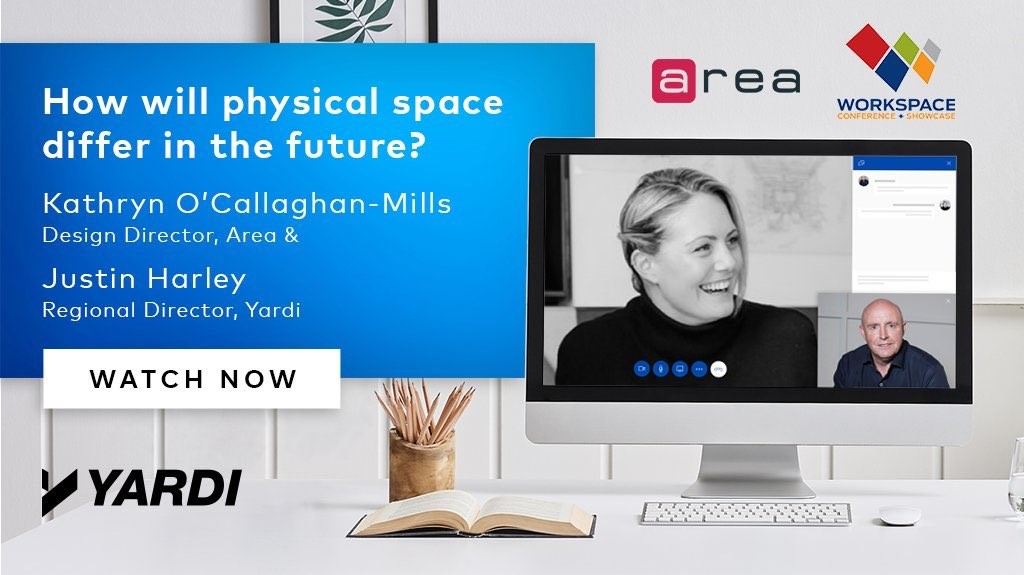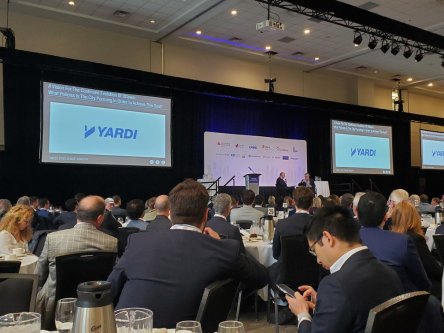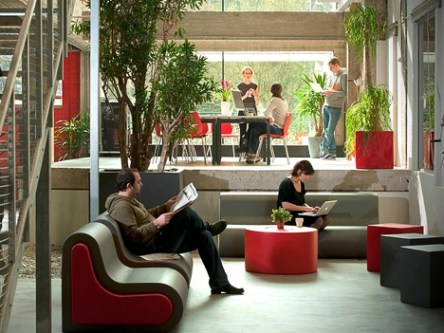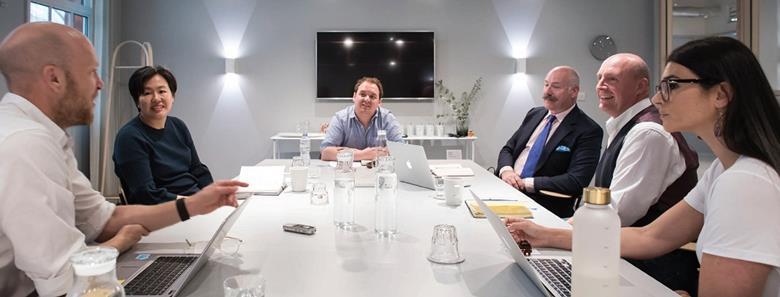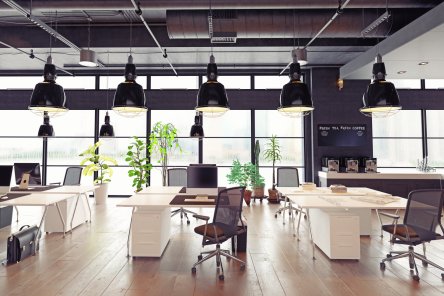Before coworking became an industry, we had coffee shops. Any café with free internet became a place where students and professionals would settle in for work. In the age of coworking spaces, coffee shops are still formidable competition—and tech innovations make the competition stronger. Coffee shops are cashing in as flexible workspaces We’ve all witnessed the coffee shop scene: with a beverage nearby, individuals and small groups hammer out ideas on their laptops or in hushed conversations. Sometimes, we’re one of them. Other times, we vie with them for table space. Coffee shops are the original flexible workspace, and more shops are converting available square footage to fill climbing demand. Awake Coffee Company opened in metro Atlanta in 2015. It was a small, tight space that wasn’t conducive to working. I went twice before finding a different spot. In 2019, Awake moved just one block away to a larger location, and now you can’t keep me out of it. It offers formal and informal coworking quarters alongside its cozy coffee operation. Awake isn’t the only shop cashing in on flexible workspaces. An increasing number of cafes seek a bump in revenue by offering coworking plans. Even restaurants in major metros are getting their cut of the pie. The New York Times reported on the shift, and it continues to gain momentum. New industries blossomed from the shift. KettleSpace and WorkEatPlay both specialize in turning food-focused locales into coworking spaces. Their clients’ clientele are people who don’t want to pay several hundred dollar or more per month for a coworking space. Additionally, they crave a relaxed, social atmosphere. These are freelancers, contractors and gig workers who love what they do because it doesn’t require a designated space. Yes, you can hold your own with the...
Flexspace Perspectives
New bitesize videos
Yardi is excited to present a series of bitesize insight videos in partnership with Property Week, ahead of Workspace 2020. This series of interviews gathers perspectives from all corners of the flexible workspace industry, reflecting on the uncertain times that we have found ourselves in during recent months. Justin Harley, regional director at Yardi, captured insights from design company Area, flexspace operator Uncommon and data analytics company The Instant Group. In the last of the series, Harley also summarised Yardi’s technology outlook. How will physical space differ in the future post-covid-19? First to take the Zoom stage, was Kathryn O’Callaghan-Mills, Design Director at Area. Harley jumps straight in with the burning question, “how will physical space differ in the future post-Covid-19?” “The beauty of workspace is that it is so flexible, and the key point of our industry is to give the user a flexible experience,” comments O’Callaghan-Mills. “Operators need to consider two main elements; people and space.” O’Callaghan-Mills explains how operators can make an impact by considering these two pertinent points, including enabling social distancing with space management and rotating people within those spaces. Staying true to the bitesize theme, O’Callaghan-Mills promotes a digestible way of thinking with a ‘the now, the next, and the future’ mindset. With ‘the now’ comprising of immediate measures you can take; ‘the next’ acts as a hybrid of the immediate measures and new normal measures; and ‘the future’ which leverages on the innovation and technology investments you make today. How will the landscape of Flexspace change? Harley also spoke to Chris Davies, Director of Uncommon. Davies expressed that “the traditional faceless office is dead.” And how “the real estate industry needs to support the needs, amenities and service demands of flexspace clients.” “Covid-19 has fundamentally changed the landscape – it’s sped up pre-existing trends such as looking after staff. Staff are the most important part of any business and make up 60-80% of most businesses and flexible office space is the corporate enabler.” Davies explained that office users want a healthier workspace and activity-based working – something that the flexspace market has a hold on over traditional office. Davies expressed how corporate companies will continue to absorb the majority of flexspace market. In 2019 40% of occupiers were corporations – Davies only sees this expanding. Companies signing 5-10-year lease agreements will be a thing of the past in Davies’ opinion. “why wouldn’t a business use a better environment for their staff?” How will the demand for flexible workspace differ post-Covid-19? James Rankin, Head of Research for The Instant Group, gave some insightful perspectives on how the demand for flexspace might differ post-Covid-19. Rankin broke his summary down into three main points explaining that demand for corporates will increase, diversification of location of the office portfolio will be prevalent, and the entrepreneurial sector will flourish. Rankin shared insights from a recent research project conducted by Gartner; “Flexspace operators are moving away from the reactionary thought process that Covid-19 has seen them take, and are now moving to make more strategic decisions about the future of flexible workspace. They are looking to reduce costs, make efficiencies and increase the flexibility of their portfolios as a whole.” Diversification of the office portfolio will be ever more important Rankin explained, “we’ve seen a large number of companies look at how they can expand out of large metropolitan, central hubs.” Rankin explained that the supply isn’t there yet in suburban markets. “We’ve seen a spike in interest for flexible workspace. 5 out of our top 13 global coworking markets are now showing interest levels higher than pre-Covid-19. The bounce back is starting to speed up.” Technology Insights & Predictions Last but not least, Harley closed the Bitesize series with a summary of his predictions and insights that Yardi has taken from clients in the industry. “The future of flexible workspace is healthy and positive,” Harley states. Harley...
Home, Office
Multifamily + Coworking
Home is where the heart is, as well as the home office for some. All the time at home in front of a computer, however, can lead to feelings of isolation, a lack of inspiration, and a lack of meeting space for collaboration. Remote employees and freelancers turn to coworking spaces for help. To avoid a hectic commute, they seek coworking offices that are as close to home as possible. Herein lies renters’ problem that is an opportunity for multifamily and coworking owners. As the number of digital nomads grows, it outpaces coworking space availability especially in midsize and tertiary markets. Many multifamily communities aren’t equipped with the space, staff, or equipment needed to successfully operate their own coworking space on premises. This is where a collaboration between coworking organizations and multifamily properties can fill the void. Renters want coworking space but providers face challenges The 2020 National Multi-housing Council & Kingsley Apartment Resident Preferences Survey indicates that 46% of renters are interested in coworking space as a community amenity. Additionally, 48% are interested in conference or meeting rooms and 37% take interest in makerspace and DIY rooms. Unfortunately for renters outside of major metropolitan areas, coworking spaces are too far away, face limited availability, or are quite pricey. Some property managers will accommodate renters by creating a coworking space within the community. When space and staff are limited, that simply isn’t an option. For coworking firms outside of major metros, high rents may necessary to stay afloat with inconsistent membership revenues. A reliable base of clients would offer stability and an opportunity for growth but getting such leads is a struggle. Multifamily property and coworking leadership may be able to work together with mutual benefit. Considerations for coworking and multifamily property managers Space...
Onward, Ottawa
Growth + Evolution
Ottawa used to be a city that thrived under the radar. Now, its growth is catching international attention. The 2019 Ottawa Real Estate Forum explored the rapid growth and evolution of the nation’s capital city. This year’s theme, “Ottawa’s on Track: The Hidden Gem of Canada” presented attendees with economic and social forecasts to inform investment decisions. The evolution of Ottawa In 2018, Ottawa was ranked the second most concentrated tech city in North America. With more than 180 tech companies in Ottawa and growing, a smart growth revolution is necessary to attract and retain talent. Yardi sponsored the session “A Vision for the Evolution of Ottawa” with His Worship Jim Watson the Mayor of Ottawa as keynote speaker. Hugh Gorman, CEO of Colonnade Bridgeport, lead a subsequent interview. Watson and Gorman discussed the need of improved efficiencies for policy approvals and repurposed buildings to help municipalities keep up with economic growth. Ottawa has plenty of space to welcome new industries and support existing businesses. At 2,790 km², it is larger than Toronto, Montreal, Vancouver, Calgary and Edmonton combined, the Mayor emphasized. Yet the evolution of Ottawa isn’t solely about new spaces and experiences. Watson encourages the reimagining of existing spaces to enhance usability. Ottawa is also making a name for itself as a center for transportation tech innovations. The city is constructing an autonomous vehicle test track. Ottawa’s vast range of weather conditions make it an excellent training ground for un-manned vehicles. When combined with the $2.1 billion new light rail system Ottawa’s status as transportation innovation center grows. Understanding the retail market Canada’s growth is undeniable. The population of 37 million is estimated to reach nearly 40 million by 2025; since 2016, major cities have created the bulk of the nation’s jobs,...
Shared Workspaces
10 Tips for Multifamily
Looking for a way to increase occupancy without slashing prices? Creative value-add amenities can distinguish your property from competitors. One such value-add feature is a coworking space. The demand for shared work spaces is on the rise. You can benefit from this by transforming an existing area into a coworking space for residents. Coworking Spaces for Multifamily? Nationwide, there are more than 57.3 million freelancers. In corporate America, 55 percent of hiring managers believe telecommuting among full-time employees is becoming a staple in their business structure. That number is expected to rise. Employers responded that nearly 38 percent of their workforce will be telecommuting within the next decade. So where are all of these freelancers and remote employees getting their work done? Their homes and coffee shops, mostly. Fortunately for you, you can be both and attract the revenue for yourself. You can create a shared workspace on your property by converting an existing conference room or business office. Add some chairs and a coffee maker and you’re done! Almost .. here’s the next steps. Must-Have Coworking Space Features Coworking offices are profitable and you can benefit from their popularity and capacity to drive revenue. You will, however, need more than a coffee maker and some chairs to get the most out of the space’s earning potential. Here are five must-haves to make your space functional. High-speed connectivity is a must. You will need to decide whether wi-fi or cable connection is right for your building. Comfortable, customizable seating is just as important as connectivity. Workers must feel comfortable if you want them to return and perceive your workspace as a reason to sign or renew their lease. To increase comfort, equip your space with a combination of adjustable office chairs at desks and...
Coworking Marketing
Strategies and Ideas
As the coworking and shared space industry continues to grow and evolve, it’s becoming much more evident that profitability is not only viable, there are ways to maximize and continue to grow your profits as an operator. Let’s dive into the best coworking marketing strategy for maximum growth. Host Events You’ve likely heard about the potential for fantastic events at coworking spaces. One of the major keys to building your brand is to hold events that are open to the local community. It’s free advertising! People who would otherwise have never stepped foot in your space get firsthand access to all the benefits your space provides. Even if they are not coworking candidates, word of mouth is one of your biggest assets. The more people know about your location, have been inside and can speak to its benefits, the better for you of course. Here are some ideas for events that you could organize within your space: Community panel discussions ‘Breakfast and Learn’ / happy hours Singles’ meetup events Yoga classes Also, keep in mind, if your space does not have 24/7 access, a great way to increase revenue is to host private events after hours. Whether it’s birthday parties, receptions, sporting event watch parties, or just about anything else that you have the room for and would take place past typical working hours. Last year’s Global Coworking Survey revealed that 21% of operators found organizing events to be a top challenge for them, and 50% said attracting new members was a top challenge. These events, whether during or after hours, will solve for a large part of both of those obstacles. Want to learn more about coworking marketing strategies? Check out the rest of this post on the Yardi Kube...
Building a Flexible Brand
Yardi UK Think Tank
New Yardi UK roundtable discussion: With more property companies launching flexible workspace brands, Property Week and Yardi gathered a panel of industry experts to identify the secrets of success in a highly competitive market. Justin Harley (JH) – regional director, coworking, Yardi Maria Cheung (MC) – director and head of interior design, Squire & Partners Giles Fuchs (GF) – chief executive, Office Space in Town Alessa McNally (AM) – head of member’s experience, The Office Group John Williams (JW) – head of marketing, The Instant Group Simon Creasey (SC) – (moderator) contributing editor/features, Property Week What are the key components needed to create a successful flexible workspace brand? GF: Location, design, building layout, staff, culture, ethos, IT, consistency of customer service. You can go on forever making a list, but all of those things need to be a part of it. AM: Location is absolutely key. It’s definitely at the top of the list of things we look for when opening up a space. Also member experience. We are here to create a memorable experience for our members. JW: I agree, it’s all about the member experience. The conventional real estate market is still referring to the ‘occupier’ or the ‘tenant’. They’re thinking about looking after an asset and not providing an experience, which is what flexible workspace providers do so well. Once people experience the flexible workspace market I think it’s a shock when they go back to conventional office space because the level of service just isn’t there. What makes a great location for a flexible workspace centre? GF: We previously had a company that covered the whole of the UK and when we opened a property outside London one of my metrics was it had to be five minutes -walk from a Marks & Spencer. In London, our MO is that the location has to be within a four-minute walk – five minutes is probably okay – of a tube or rail hub. JW: I said two years ago that we were going to start to see the rise of second cities and coworking and flexible space becoming a story in the regions and I’m glad to say I was right. Demand for flexible workspace in cities like Bristol, Birmingham and Manchester is increasing by 25% to 30% every single year at the moment. Those secondary cities in the UK are really flying and we’re also seeing that in Europe and in the States. How important is design and fit-out to a flexible workspace brand? MC: It’s become massively important. It should have always been massively important, but the standards have been raised and everyone is really enjoying and realising the benefit of great design in the workspace. It’s no longer about sitting at a fixed desk. We are working in different ways. People want to be able to sit, to stand, to walk around and look at things. Design can enhance and allow different ways of working through the use of things like natural light, biophilia, control of the environment and even acoustics. JH: One of my favourite spaces in London is [flexible workspace provider] Uncommon. They have a lot of biophilia, but it’s the scent in their buildings that’s really beautiful. Smell is one of the most important senses. JW: I think there is a perception of how coworking and flexible space should look; it’s a bit like coworking design bingo. There should be exposed brickwork, free beer, lots of dogs and avocados on tap, but that’s not the case. There is a real individuality of different approaches and different spaces being provided. In the flexible workspace and coworking sector the word ‘community’ pops up time and time again. How important is it to create a sense of community in your flexible workspace? MC: When we created The Ministry [The Ministry of Sound’s private members club and coworking space] we worked closely with them...
Coworking Outlook
Changing the tech landscape
Editor’s note: this coworking perspective piece was authored by Justin Harley, regional director of coworking for Yardi, in association with Property Week. Harley was a co-founder of the flexible workspace management software Hubcreate. He joined the Yardi UK team in May. Having spent most of my career in the flexible workspace sector, I could not be more enthusiastic about how bright the future is for coworking and flexspace, and furthermore I am delighted to see technology and software leaders such as Yardi investing heavily in technology to fuel the growth and development of the sector. I have been privileged to see the coworking and flexspace sector grow from a few London-based serviced offices to what it is today, one of the fastest-growing parts of the real estate world. That said, it still only accounts for 4% of all deals in London, according to the latest research from Cushman & Wakefield and Colliers International. While real estate continues to develop an understanding of the coworking market, the industry is still a little shell-shocked about how it has crept up on them. That part of the real estate sector often misses the point when they debate coworking. I hear “we are not coworking, coworking doesn’t make money – when will the bubble burst?” Larger operators account for less than 13% of the market in the UK and the flexspace and coworking community is made up of businesses that care about innovation, member experience and the effect of their service on worker wellness. In short, it’s all about the customers and what makes them happy. Their obsession for customer service is what drives the industry. A happy client is a loyal client and, despite being on a flexible license, will stay for a long time. It is...
Flexible Workspace
Topic of Yardi Think Tank
Yardi assembled a panel of flexible office experts to discuss the importance of a service ethos, how workspace providers can stand out from the competition and why the sector looks well placed to weather a possible recession. Panelists Gareth Evans, chief executive of BizSpace Katrina Larkin, co-founder of Fora Cal Lee, founder of WorkThere William Newton, president of Wiredscore Katie Whell, managing director at Pure Offices Tony Freeth, director of coworking at Yardi Simon Creasey, features editor at Property Week (chair) Flexible workspaces have been hailed as the future of offices, but as the business model continues to mature many questions arise about what this future might look like. To debate what lies ahead for flexible workspaces, Yardi put together a panel of some of the industry’s heavyweights. SC: How important is customer service for the coworking industry? GE: Customer service is what it’s all about. It’s quite interesting as a concept because one person’s customer service is another person’s lack of service. It depends on where you are regionally, what kind of centre you’re in and what people’s needs are. You can provide frothy coffee or whatever, but if that’s not what the customer wants then you’re not providing good customer service. KL: Myself and [Fora co-founder] Enrico [Sanna] come from a hospitality background, not from a workplace background. So, for us, customer service is absolutely key. We have worked with one of the top hospitality schools in Switzerland to attract the best people from the hospitality industry. WN: Before WiredScore moved into WeWork, we were with a provider who clearly hadn’t yet got what service meant. Their front of house people were security people trying to prevent people getting into the building who shouldn’t be there rather than welcoming in guests who...
Flexible Workspace
Q&A with Tony Freeth
Editor’s note: The following interview originally appeared in GCUC UK and is reprinted with permission here. Tony Freeth has seen the evolution of the office space industry firsthand. Co-founder of Phoenix Broadband and creator of Medusa, a product that handles premises infrastructure, Freeth has played a pioneering role in bandwidth management and workspace wifi solutions since the late-1990s. Recently, Medusa was acquired by global real estate technology company Yardi. Freeth, who was at the first Global Coworking Unconference Conference (GCUC) in Austin, Texas in 2012, has now taken the role of Director of Coworking Europe at Yardi. With two decades of experience, Freeth provides a unique and valuable perspective on the now-booming workspace industry. We spoke with Freeth about the evolution of the industry, Yardi’s acquisition of Medusa, and how commercial real estate has now adopted coworking as an asset class. Here are the highlights of our conversation. What’s your coworking story, Tony? How were you introduced to what was then a small movement? Tony Freeth: In 2010, I was talking to someone at Steelcase who told me I needed to go to Coworking Europe. While there, I came across a bunch of people who had a very different idea of how people could work in a space, based on collaboration and community. We tried to sell that message to our conventional customers for many years, and for a long time their response was, “No that’s not what we do. Everyone wants a door.” We told them when you put millennials behind doors, it’s like depriving a plant of light—they just wilt. I met [GCUC producer] Liz Elam at Coworking Europe and she invited me to Austin for GCUC. It became clear that U.S. coworking seemed extremely vibrant and extremely well-organized. I imagine your...


